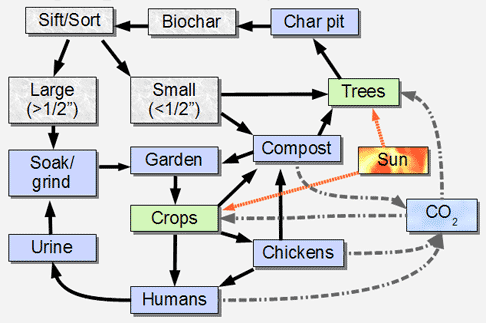It’s been seven years since I posted anything to this blog, but it’s a reasonable place to put things I’ll want to refer back to, so…
There are currently two biochar pits. Pit 1 is the original, and Pit 2 (built July 2015) is a larger pit which incorporates lessons learned from the first pit. I always fire both together. When the pit is fired then opened up later, there is a gap at the top with air and a few chunks of wood that were not fully charred, which are removed, leaving a depth of char which is less than the depth of the pit. Here are both pits, freshly opened, with the torrefied wood still in place:
And Pit 2, emptied:
| Width (inches) | Length | Depth | Depth of char | Cubic inches | Cubic feet | Cubic yards | Liters | |
| Pit 1 | 29 | 53 | 23 | 16 | 24592 | 14.2 | 0.53 | 403 |
| Pit 2 | 31 | 63 | 25 | 18 | 35154 | 20.3 | 0.75 | 576 |
| Total | 59746 | 34.6 | 1.28 | 979 |
In terms of carbon, it is difficult to say how much C is present in this partly-crushed, loose char. A solid block of charcoal, a web search indicates, might be 13 lbs/ft3. Another source, biochar-specific, says it could vary widely from 5 to 20 lbs/ft3. Using a value of 10, that gives 346 lbs of carbon, equivalent to 1270 lbs of CO2. By a (similarly, very rough) approximation of the carbon footprint of air travel, at 1 lb CO2/mile, a flight from Hawaii to California (~2400 miles) would require two complete firings of the charpits to offset the flight emissions, or four complete firings for a round trip. This analysis does not include the other (relatively small) carbon costs of the charpits, including per-burn costs (small amounts of gasoline for chainsaw and log-splitter) and amortized costs (footprint of the bricks used to build the pits).
In terms of time and money, looking around on this island, the approximate price of biochar is $150 per cubic yard. (That equals $5.55 per ft3, so a 5-gallon bucket (0.67 ft3) would be $3.70.) At that price, the pits produce $192 worth of char. Firing the pits takes around 4.5 hours (can be anywhere from 4 to 5 depending on many factors). There is also time spent unloading, as well as gathering, cutting, splitting, and moving the wood to the charpits; these hours are harder to estimate but we can imagine another 3 hours per amount of wood that goes into a firing. That gives around $25/hour for the 7.5 hours of labor involved in each batch of char.



